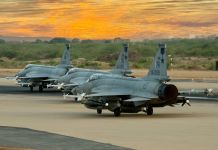The possible procurement of the Russian S-400 missile defence system by Turkey and India has been a thorn in the crown of the US weapons monopoly. With the US pushing forth threats of sanctions against the states as per the Countering America’s Adversaries Through Sanctions Act (CAATSA), the looming threat has not deterred the adamant Turkish and diplomatic Indian government to sign and seal the deal with Moscow. A EurAsian Times analysis.
Block F-35 Fighter Jet Sale To Turkey If Ankara Acquires S-400 Missiles: Top US General
India has also been forewarned of the implications of signing the S-400 deal with Russia which was signed early last year. There have been many attempts by Washington to lure India away from the S-400 deal and was tempted by Patriot missiles batteries along with other incentives, but India has not budged.
Defence experts that EurAsian Times talked to state – It is common knowledge that the S-400 is a far more superior defence system than the American-made Patriot system. The S-400 is considered by far the best air defence system in the world today with proven capabilities and Washington desists to bring its fifth generation fighter jet against the Russian missiles (Turkey being the prime example)
The American side has been trying to dissuade India and Turkey to step away from the deal and invoking CAATSA is also on the table. The S-400s are found to be more capable in air defence than the Patriot missile systems (PAC-3) with the latter showing shortcomings in effectively neutralising aircraft and ballistic missiles.
The S-400 Missiles Neutralises The Threat of ‘Stealth’ F-35 Fighter Jets – Defence Experts
If one were to compare the two missile systems, we would find some interesting results as per secondary research by EurAsian Times
• The S-400 missile can engage 72 targets and track 160 targets at the same time while the Patriot/PAC-3 can only engage 36 and track 125 targets.
• The deployment time for the S-400 is 5 minutes while that of the Patriot PAC-3 is 25 minutes.
• The S-400 can locate targets that are 600 km away and destroy within 400 km range while the Patriot/PAC-3 can locate targets at 180 km.
The Patriot systems have shown various shortcomings in the combat during the actual deployment. This is a matter of concern that makes the S-400 a much more lucrative buy besides keeping the Russians by the Indian and Turkish side.
The biggest selling point for the S-400 is in its ability to track and target stealth aircrafts. Though the S-400 has not been tested against the American F-22 or F-35’s, but its reputation as a formidable competitor is well acknowledged within the defence circles.
The US has raised concerns regarding the S-400s and are in every possible method trying to block nations from purchasing arms from Russia. India has been one of Russia’s most important buyers and the recent move towards defence overhaul in the country has caught the eye of the American defence market which seeks to jump at this cash-stacked market. The current Trump administration has taken a very close interest in strengthening ties with India, whom it considers an important aspect of Trump’s Asia Reassurance Initiative Act (ARIA).
The fact that India has signed the deal with Russia on the S-400s is a blow to the Americans, this comes close after the Turkish government adamantly sought to stick with the procurement of defence systems from Moscow.
The prior warnings had not deterred the Turkish government one bit which has irked Washington. Even though the Turkish government has assured the NATO allies that the S-400s would not fall under NATO operability, but Washington is in no mood to relent. The US continues to persuade both Turkey and India, but it’s unlikely that Delhi and Ankara would budge from their stance and compromise with national security.
The fact that there is no equal match to the S-400s in the market at the moment makes for a very difficult conversation for the American defence manufacturing wing. Despite the many tactics to coax India away from the deal, it will be rather difficult to dissuade a nation looking for advancement and progress. The Indian defence market has always been fiercely independent and the Turkish adamancy has only added more fuel to India’s determination.




